In 1948, Hudson introduced the innovation that would both inspire one of the most famous cars of all time, and contribute to the demise of the Hudson name: the Step-Down. The Step-Down affixed the floorplan of the car at the bottom of the frame instead of the top, lowering the car’s center of gravity and allowing for more headroom. The car’s roofline could also be lower and coupled with sleek ponton styling, this generated several sales winners. One of these was the Hudson Hornet, introduced for the 1951 model year. Here on craigslist is a 1953 Hudson Hornet Twin H-Power car for sale, priced at $6,000 and located in Coronado, California. Thanks to T.J. for this fabulous tip! The downsides to the new chassis/floor configuration were not anticipated when Step-Down was introduced. These included increased weight and thus price; and rendering re-design nearly impossible. Panel placement and form were dictated by the chassis; in fact, Cadillac took a close look at the Step-Down and concluded that it wasn’t practical. Meanwhile, the market had shifted from favoring sellers to favoring buyers. The largest car companies accelerated design and production competition for customers, forcing independents out of business. Hudson, losing money and made less nimble by its own devisement, was forced into a merger with Nash by 1954.
This Hornet is a daily driver with substantial work already completed. The brakes have been upgraded and refreshed; the car has a header; the tires are new; the motor, while not the original block, is still a 308 cu. in. inline six-cylinder with rebuilt twin Carter single-barrel carburetors. The wiring harness has been replaced and the car has a 12-volt GM alternator. Adding to the allure, the entire suspension has been rebuilt. Many other items have been improved or renewed. Obviously, the car could use bodywork and paint, but … maybe not! It runs like a champ and only has a couple of small rust holes that could easily be patched. Driving around in a mechanically great car when you don’t care about parking lot dings is a relief.
The interior is problematic. The rear seats are as ratty as the front bench. I don’t mind a crusty exterior so long as the rust is controlled, but the interior is where I live. Fortunately, panels and upholstery are available. This car has two-speed Powerglide transmission which the seller indicates could use some maintenance. The wipers also need some work. But these negatives should not detract from the magic of a car that can be a daily driver.
We can’t complete this article without mentioning the Hornet’s NASCAR success. The handling and center of gravity advantages of Step-Down construction made the Hornet shine on the race track. The tuned version of a Twin H-Power motor put out 210 bhp and helped bring home the trophies. Over the course of three seasons, Hudson dominated NASCAR under the likes of Marshall Teague, Tim Flock, Dick Rathman, and of course Herb Thomas with Smokey Yunick as crew chief. While this car is not Fabulous yet, it’s on its way.





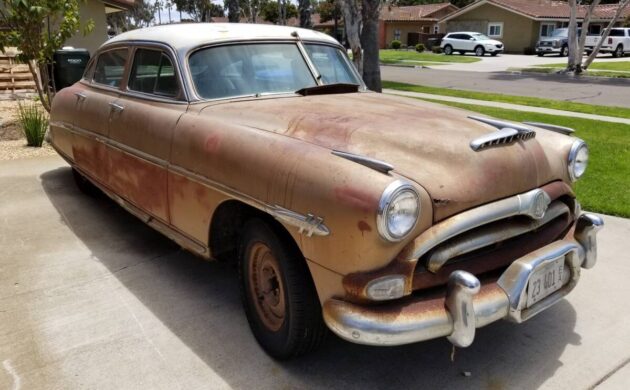

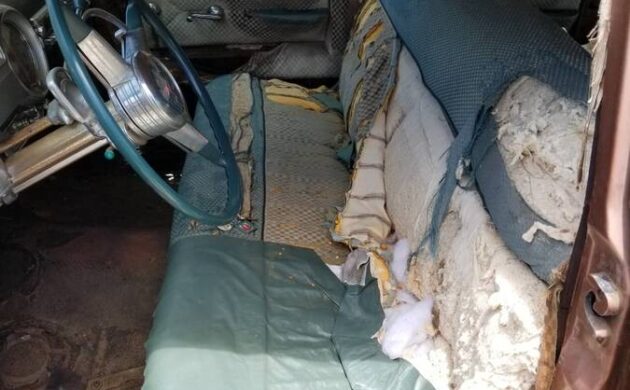
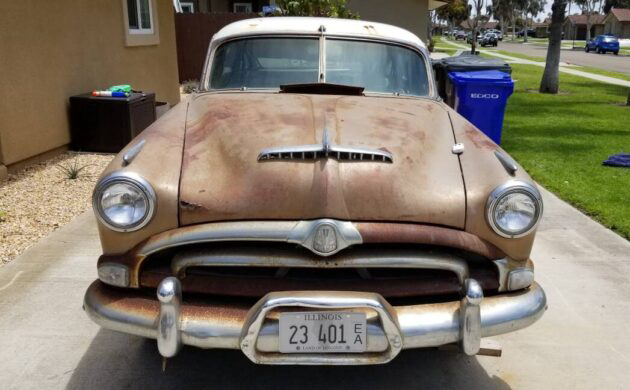
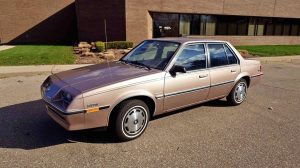

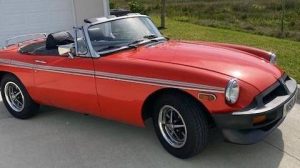
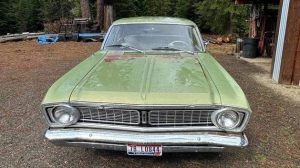


“Original” P-glide? All the Hudsons I saw from this era had Hydra-Matic transmissions. I hope this doesn’t mean the thing only has two of its four forward gears functioning.
Although I’d prefer a two-door — because of the aforementioned Teague, Thomas, Yunick and of course the Flock Brothers — the lure of Twin H-Power is strong. A short drive in one made it clear the big Hudson “six” was a real torque monster, more so when the dual carbs and manifolds were supplied.
Too bad it can’t be taken to “The Best Damn Garage in Town” for a tune-up….
I questioned the tranny reference too but then researched showed several references to the two speed p-glide.
https://www.google.com/amp/s/www.mercurynews.com/2015/04/10/1951-hudson-hornet-is-a-peoples-car-a-hit-with-adults-and-kids-alike/amp/
That sounds like some crossed wires, or misunderstanding, in the article about the type of automatic transmission.
In 1951, when Hudson began offering the GM Hydra-Matic, they used the variation dubbed “Single-Range” which was still a 4-speed. In 1952, Hudson switched to the “Dual-Range” Hydra-Matic. The difference between the 2 is that you can lock the “Dual-Range” in 3rd, whereas the “Single-Range” goes through all 4 gears when in Drive.
There was also a fire at the Hydramatic plant in 1953. I know Cadillac used the Buick Dynaflow and Pontiac used the Powerglide as a stopgap. Not sure what Oldsmobile used, but maybe some Hudsons received the Powerglide?
Hudson used the Borg-Warner 3 speed automatic when it couldn’t get any Hydra-Matics from GM. My ’54 Hornet Hollywood (built in December of 1953) has the B-W transmission.
The garage is on display in Don Garlits’ museum in Florida.
My grandfather drove nothing but
Hudson’s until they stopped building
them in ’57. And though my memory
is somewhat dim now, I can still recall
the last one he owned– a 2 tone blue
’52 Hornet sedan similar to this one.
My Mom said that it had twin H-power and that it was a 3-speed with
OD. The only thing I recall now is the
feeling of being swallowed up by those thick cushiony seats! I was
very young then maybe 3 or 4 at the
time but I can still see my grandfather
rowing through the gears. After he
sold the Hudson, he bought a new ’58
Ford wagon that rusted out within 2
years. He then bought a ’60 Chevy
Impala wagon in ’61 and it was all Buicks after that. Til the day he died,
he would always tell me how much he
missed his Hudson’s.
Thanks for the write up with the history of the Step Down design and it’s affects on the automotive world. Very interesting reading.
The only factory options on the transmission available for this car from the factory were the hydramatic, standard 3 speed and 3 speed with overdrive. Poeple over the last 69 years could have put anything in it but thats what came from the factroy. Also, the weight for this car was not as high as some have indicated due to the unibody or’Monobuilt’ chassis and body construction. The stance of stepdown Hudsons were also a bit different than the industry standard. Front end was wider than the rear and the front seat of the car was longer than the height of the car. These cars can go very fast and keep up with current highway traffic. They handle very well and are a blast to drive. Good price if this car is decent.
There’s no question in my mind why this car exists at all, it was the Twin-H feature. Nobody kept a “regular” Hudson. Interestingly mentioned, the moniker “Step-Down” was not only it’s selling point, but also it’s downfall. Who wanted to “step down” when cars were becoming engineering marvels. In America, it was always a “step up”. Obviously, not Hudsons intent, the step down was also a safety feature, and these cars boasted the 1st “chopped top” from the factory. While Hudson struggled to compete with all the other postwar “orphans”, I read, at one time, there were almost 4,000 Hudson dealers. To be fair, I think, the only reason for Hudsons success on the race track, is people were just finding out about the Olds V8, and the Hudson was soon history. And I’d like to rap the seller behind the head with a newspaper ( a what, grandpa?) ,,,daily driver? Like this? Don’t people have a shred of pride anymore? These were beautiful cars, looks like crap.
As you well know & unfortunately, it’s pretty much today “anything goes”…..no pride isn’t the problem…..no shame IS though.
Patchy the rust and repaint and you would have a reliable daily diver
I would have to repair the interior to make it a daily driver, or at least a daily drive-able. The exterior is fine the way it is, I wouldn’t be ashamed of it at all. Those “judges” who think it’s awful to operate the vehicle “as is” should actually be grateful it hasn’t been crushed and recycled into Ensure cans.
The next owner can always finish the car to the judges’ standards, nothing is carved in stone here.